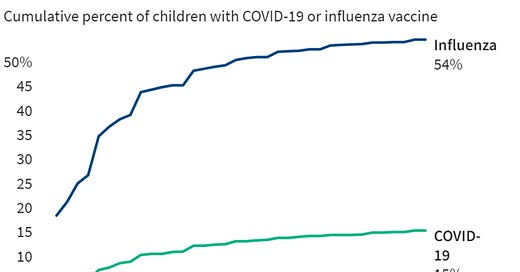Source: Williams et al KFF, July 18, 2024 LINK
Speaking of pediatric vaccinations, KFF reported this month that vaccination rates of children entering kindergarten have not rebounded since the decline of immunizations during the pandemic. The Healthy People 2030 target is to have 95% of children immunized for MMR (measles, mumps and rubella,) but three-quarters of states were below this goal last year. Four times as many states were below 90% of children immunized with MMR. Virologists say that a vaccination rate of 95% is necessary to prevent future widespread outbreaks. KFF estimates that 250,000 school children were unvaccinated and not protected against measles.
KFF reports that pediatric influenza vaccination rates declined during the pandemic, although they remain about three times higher than COVID vaccination rates (see chart above). The researchers also found that vaccine exemptions rose from 2.5% (2019-2020) to 3.0% (2022-2023), and there have been efforts in many states to relax enforcement of vaccine requirements.
Vaccine exemption rate, 2022-2023 by state
Source: Williams, et al KFF, July 18, 2024 LINK
Implications for employers:
- As I noted in Friday’s post, childhood vaccinations are cost saving, and employers should expect increased medical costs if pediatric vaccination rates continue to decline.
- Pediatric illnesses are also a major cause of employee time away from work.
- Employers can seek reporting from carriers on rates of childhood vaccinations, and can ask carriers what efforts they are making to encourage pediatric vaccinations.
- Employers can remind their members that pediatric vaccines are available without cost sharing.
Thanks for reading. You can find previous posts in the Employer Coverage archive
Please subscribe, “like” and suggest this newsletter to friends and colleagues. Thanks!
Wednesday: New data show opportunities to improve women’s health care




